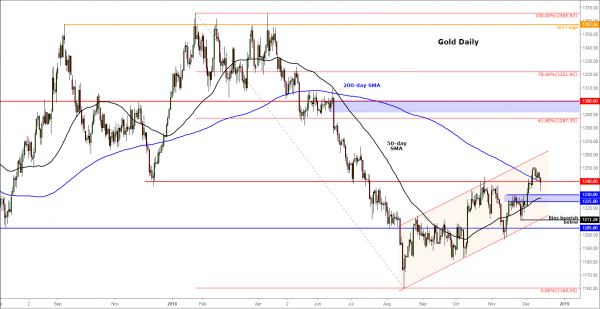We are arguably heading to one of the most important weeks in months for the dollar, certainly the most vital one before the year is out, as the Federal Reserve decides on interest rates. In addition to the Fed meeting, we will have two other major central bank meetings – namely, the Bank of Japan and Bank of England (both on Thursday) – and some key global macroeconomic data to look forward to as well next week. Out of these three central banks, two are almost guaranteed to keep their respective policies unchanged. Need I mention which two? The Federal Reserve, on the other hand, is highly likely to hike interest rates for the fourth time this year. The key question is this: How many more hikes – if any – to come in 2019? The FOMC will hopefully provide us with fresh clues in this regard as they will have updated their projections on the economy and interest rates. Consequently, the dollar’s next directional move should become clearer. As well as the greenback, we could also see sharp moves for buck-denominated gold and silver, as well as bonds and equities.
US interest rates set to rise to 2.00-2.25 percent
The Fed’s decision on interest rates will be known on Wednesday December 19 at 19:00 GMT or 14:00 ET, with Fed Chair Jerome Powell’s press conference starting half an hour later. It is widely expected that the FOMC will vote for a 25-basis point rate increase, pushing up the Federal Funds Rate to between 2.25 and 2.50 percent from the current 2.00-2.25 percent range. Whether the dollar will be able to extend its year-long rally or ease back will depend to a large degree on any potential changes in economic and interest rate projections the FOMC had made at its September meeting.
FOMC could pause hiking in 2019 due to recent developments
We think there is a possibility that the days of the dollar’s reign as King of FX could be numbered. The Fed may very well signal a pause in near future rate hikes after potentially tightening its belt one more time next week, owing in part to ongoing uncertainties related to geopolitical factors, recent financial market volatility and weaker demand due to the currency crises in emerging market economies. While this could certainly weigh on the dollar in the short-term, we are not sure if it will be the end of the longer-term rally. After all, other major central banks are also not in a rush to tighten their belts.
BoE’s hands tied due to Brexit and BoJ running out of things to buy
As far as the other two central banks are concerned, well don’t expect to hear too much new information from them. The Bank of England’s hands are tied because of the B word. The BoE simply cannot justify tightening its belt, while the risks of a no-deal Brexit is there. Meanwhile, the Bank of Japan has thrown the kitchen sink at trying to stimulate inflationary pressures in the economy but has been largely unsuccessful, although through no fault of their own. The central bank is running out of assets to buy as its balance sheet swells. We don’t expect to see any new announcements. Sooner or later, though, the BoJ will have to unwind its huge balance sheet, and if we hear any hints about that, the yen could rally hard.
Data highlights
Meanwhile some of the key data releases in the coming week include: German Ifo Business Climate and US Building Permits and Housing Starts on Tuesday; UK and Canadian CPI estimates, and late in the day, New Zealand GDP on Wednesday; Aussie employment and UK retail sales will be in focus on Thursday, followed a day later by US durable goods orders as well as Canadian retail sales and GDP on Friday. It is unlikely the markets will react in a significant way to any of these data releases, as the focus will clearly be on the Federal Reserve.
Gold could break out if Fed is more dovish
As we think the dollar might ease on the back of a dovish Fed, buck-denominated gold could break higher – especially in light of recent falls in stock markets, boosting the appeal of the safe-haven metal further. Technically, we are bullish on the precious metal until and unless it breaks its rising trend line or forms a major reversal pattern at higher levels first.


 Signal2forex.com - Best Forex robots and signals
Signal2forex.com - Best Forex robots and signals




